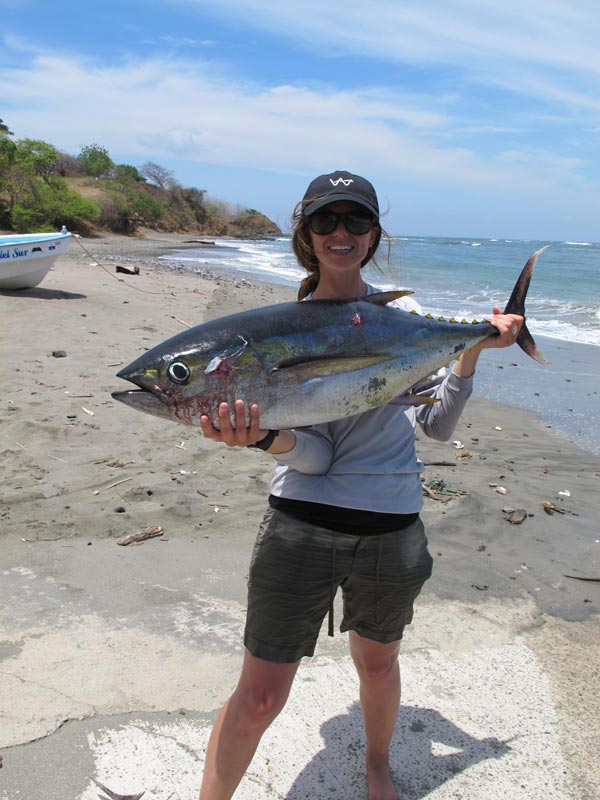Study finds toxic pollutants in fish across the world's oceans

Scripps researcher Lindsay Bonito holding a yellowfin tuna. Credit: Scripps Institution of Oceanography at UC San Diego
A new global analysis of seafood found that fish populations throughout the world's oceans are contaminated with industrial and agricultural pollutants, collectively known as persistent organic pollutants (POPs). The study from researchers at Scripps Institution of Oceanography at UC San Diego also uncovered some good news?concentrations of these pollutants have been consistently dropping over the last 30 years.
The findings, reported in the Jan. 28, 2016 issue of the journal PeerJ, were based on an analysis by Scripps researchers Lindsay Bonito, Amro Hamdoun, and Stuart Sandin of hundreds of peer-reviewed articles from 1969-2012. The pollutants studied included older 'legacy' chemicals, such as DDT and mercury, as well as newer industrial chemicals, such as flame retardants and coolants.
“Based on the best data collected from across the globe, we can say that POPs can be anywhere and in any species of marine fish,” said Scripps biologist Sandin, a co-author of the study.
Although POPs were found in fish in all of the world's oceans, the researchers say that concentrations in the consumable meat of marine fish are highly variable, where one region or group of fish may find concentrations of POPs that vary by 1,000-fold. The analysis revealed that average concentrations of each class of POP were significantly higher in the 1980s than is found today, with a drop in concentration of 15-30 percent per decade.
“This means that the typical fish that you consume today can have approximately 50 percent of the concentration of most POPs when compared to the same fish eaten by your parents at your age,” said Bonito, the lead author of the study. “But there still remains a chance of getting a fillet as contaminated as what your parents ate.”
The researchers also compared the results to federal safety guidelines for seafood consumption and found that the average levels of contaminants were at or below the health standards set by the U.S. Environmental Protection Agency (EPA). Mercury and PCBs (polychlorinated biphenyl) concentrations were at the EPA threshold for occasional human consumption, while concentrations of DDT were consistently much lower than the established threshold.
According to the authors, these results suggest that the global community has responded to the calls-to-action, such as in the Stockholm Convention, to limit the release of potentially harmful chemicals into the environment.
The authors caution that although pollutant concentrations in marine fish are steadily declining, they still remain quite high, and that understanding the cumulative effects of numerous exposures to pollutants in seafood is necessary to determine the specific risk to consumers.
###
The study was funded by the Waitt Foundation.
Scripps Institution of Oceanography: scripps.ucsd.edu
Scripps News: scrippsnews.ucsd.edu
About Scripps Institution of Oceanography
Scripps Institution of Oceanography at the University of California, San Diego, is one of the oldest, largest, and most important centers for global science research and education in the world. Now in its second century of discovery, the scientific scope of the institution has grown to include biological, physical, chemical, geological, geophysical, and atmospheric studies of the earth as a system. Hundreds of research programs covering a wide range of scientific areas are under way today on every continent and in every ocean. The institution has a staff of more than 1,400 and annual expenditures of approximately $195 million from federal, state, and private sources. Scripps operates oceanographic research vessels recognized worldwide for their outstanding capabilities. Equipped with innovative instruments for ocean exploration, these ships constitute mobile laboratories and observatories that serve students and researchers from institutions throughout the world. Birch Aquarium at Scripps serves as the interpretive center of the institution and showcases Scripps research and a diverse array of marine life through exhibits and programming for more than 430,000 visitors each year. Learn more at scripps.ucsd.edu and follow us at: Facebook | Twitter | Instagram.
About UC San Diego
The University of California, San Diego is a student-centered, research-focused, service-oriented public institution that provides opportunity for all. Recognized as one of the top 15 research universities worldwide and born of a culture of collaboration, UC San Diego sparks discoveries that advance society, drive economic growth and positively impact the world. Our students, who learn from Nobel laureates, MacArthur Fellows and National Academy members, are committed to public service. For the sixth consecutive year, UC San Diego has been ranked first in the nation based on research, civic engagement and social mobility. We are one campus with multiple pillars of excellence, a top ten public university that is transforming lives, shaping new disciplines and advancing the frontiers of knowledge. Learn more at http://www.
Media Contact
All latest news from the category: Life Sciences and Chemistry
Articles and reports from the Life Sciences and chemistry area deal with applied and basic research into modern biology, chemistry and human medicine.
Valuable information can be found on a range of life sciences fields including bacteriology, biochemistry, bionics, bioinformatics, biophysics, biotechnology, genetics, geobotany, human biology, marine biology, microbiology, molecular biology, cellular biology, zoology, bioinorganic chemistry, microchemistry and environmental chemistry.
Newest articles

Pinpointing hydrogen isotopes in titanium hydride nanofilms
Although it is the smallest and lightest atom, hydrogen can have a big impact by infiltrating other materials and affecting their properties, such as superconductivity and metal-insulator-transitions. Now, researchers from…

A new way of entangling light and sound
For a wide variety of emerging quantum technologies, such as secure quantum communications and quantum computing, quantum entanglement is a prerequisite. Scientists at the Max-Planck-Institute for the Science of Light…

Telescope for NASA’s Roman Mission complete, delivered to Goddard
NASA’s Nancy Grace Roman Space Telescope is one giant step closer to unlocking the mysteries of the universe. The mission has now received its final major delivery: the Optical Telescope…



